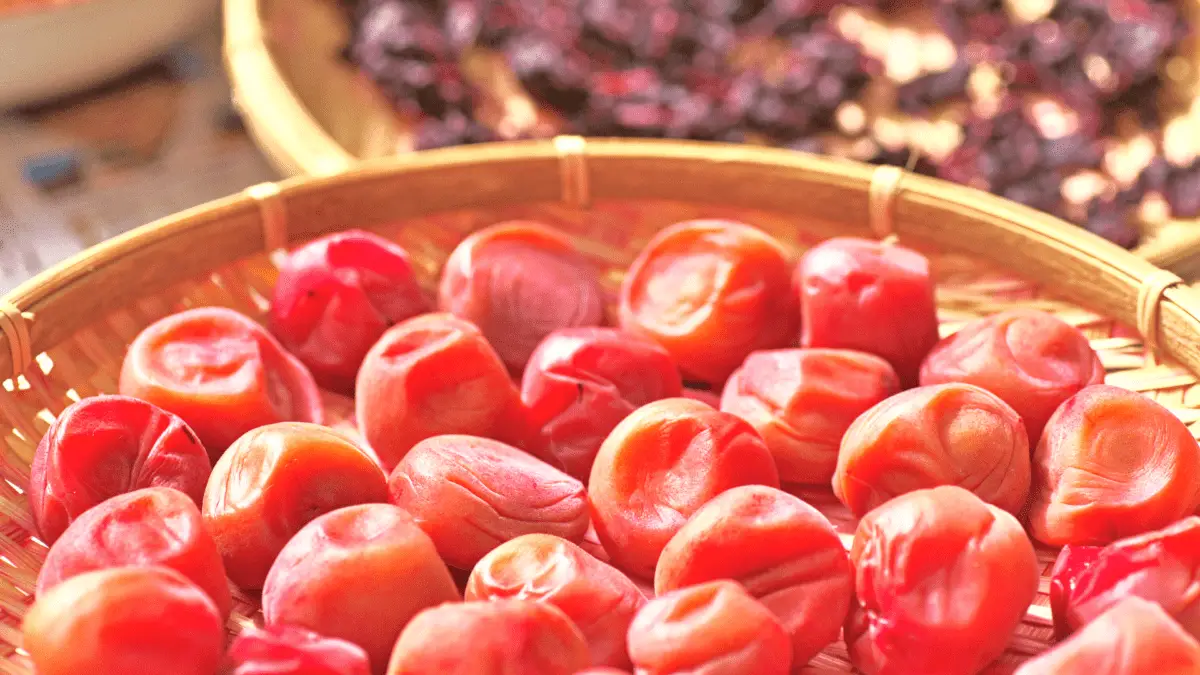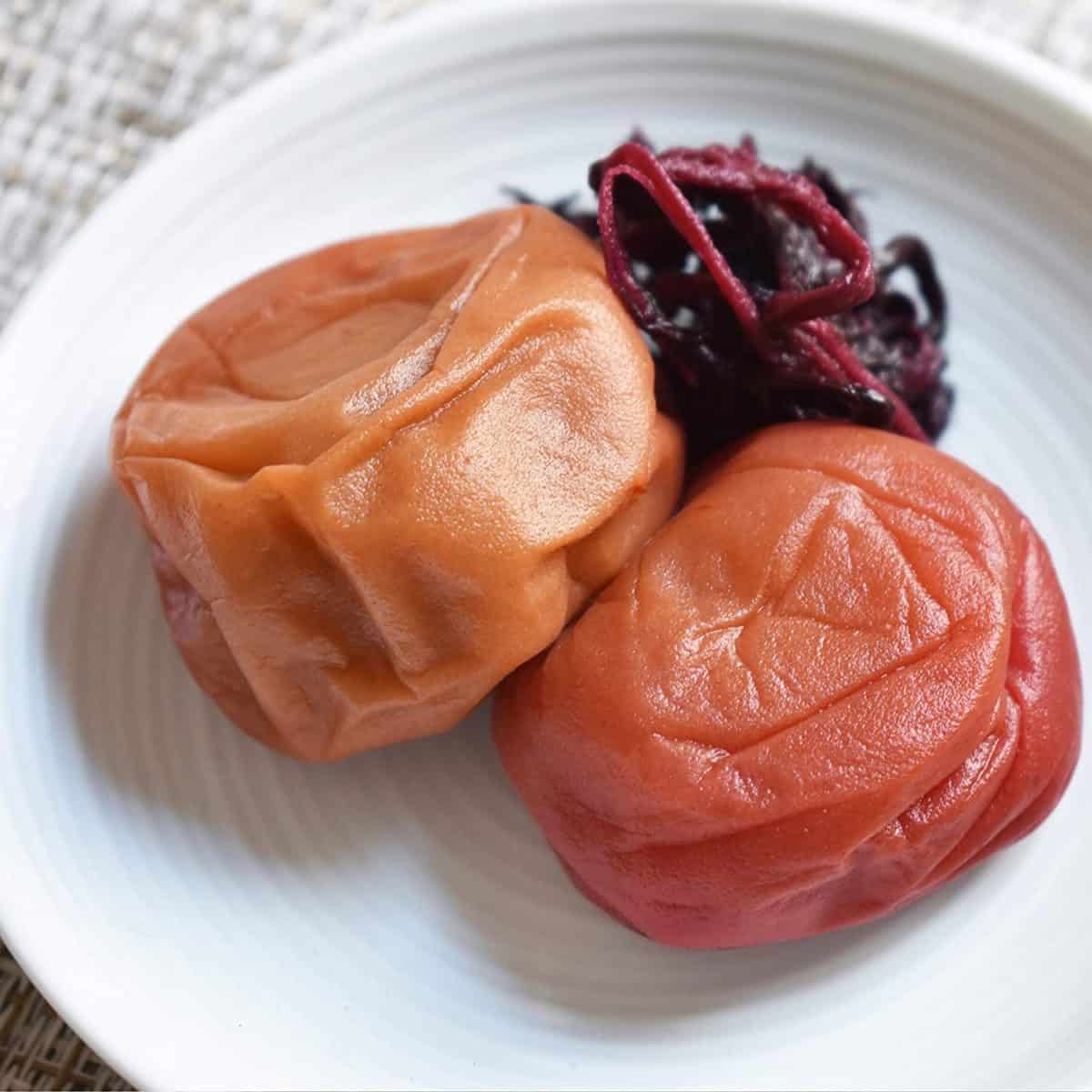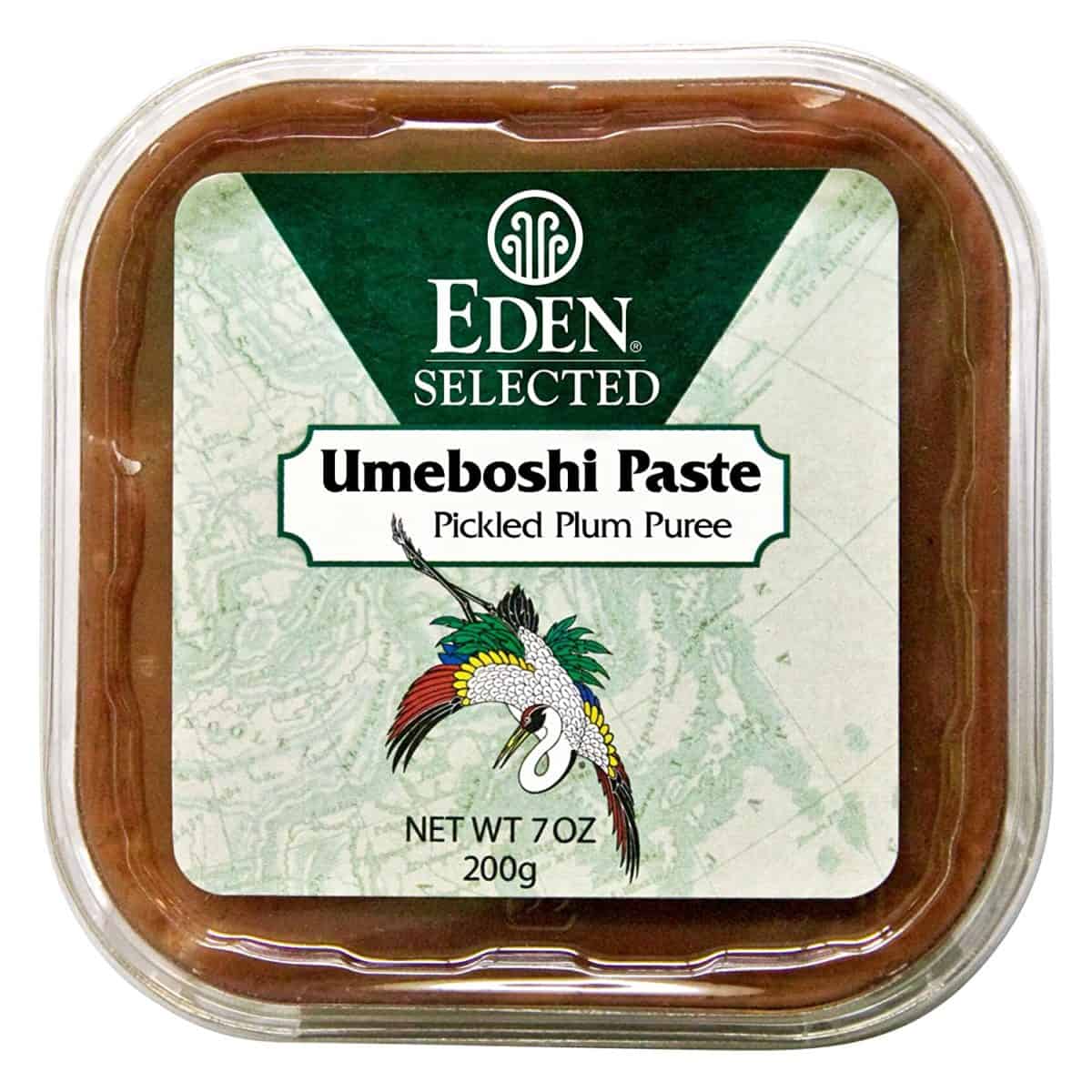What is umeboshi? A complete guide on the Japanese flavor powerhouse
There’s only one thing that has an edge on shiitake mushrooms in Asian cuisine when it comes to health and taste. And that is umeboshi.
Some call it the “superfood” or “longevity secret” of Japan; others call it the “energy booster of samurais.”

However, when we look beyond the ancient folklore and the words of overstates, it’s just a pickled ume fruit, or “salted plums,” as they call it.
Umeboshi is prepared by salting or drying fresh ume fruits, which are closely related to the family of apricots and plums. It has a very salty and sour taste and is available in whole and paste form. They are a popular Japanese cooking condiment and are regarded to have many scientifically proven beneficial properties.
Umeboshi is one of the healthiest fruit condiments out there!
In this guide, I will explain precisely how it is made, what makes it so special, and more importantly, how you can use it in your own culinary adventures.

Check out our new cookbook
Bitemybun's family recipes with complete meal planner and recipe guide.
Try it out for free with Kindle Unlimited:
Read for freeIn this post we'll cover:
What is umeboshi?
Umeboshi is a salt-pickled ume fruit, also known as the “Japanese pickled plum.” It is used as a condiment in Japanese cooking, for example, in onigiri balls, furikake mixes, and as a pickle accompanying a meal.
Though generally called ‘plum,’ it is necessary to mention that the term is merely used for convenience.
The fruit is more closely similar to apricots than plums.
Umeboshi is prepared by dry packing unripe ume plums with salt with some red shiso leaves for four to seven days.
The salt draws out the moisture from the fruits, which created a brine for the fruits to soak in.
Next, the fruits are extracted from the brine and dried in the sun.
The sun-dried plums are then put back into the liquid or kept as is in a container to age.
On an industrial scale, the tart liquid extracted by the salt from umeboshi is marketed as “ume plum vinegar” or simply “plum vinegar,” despite not being a true vinegar.
You can buy prepared umeboshi as whole fruits to use as a condiment. I like the Kishu Nanko-ume brand because no artificial sweeteners have been added.

If you are not a huge fan of whole plums or want to ease yourself from efforts like chopping umeboshi, there’s also umeboshi paste available in the market.

Apart from being one of the most common condiments in Japanese cuisine, it is also known for its medicinal significance in preventing and curing many diseases.
Stimulation of the digestive tract, detoxification of the body, treatment of ulcers, and increasing endurance of kidneys and liver are just a few health benefits.
Just like the shiitake mushrooms, umeboshi has been a prominent subject of ancient folklore and is known for its “magical effects” on the body.
That could also be one of the reasons why most Japanese households don’t seem to start their day without having at least a bite or two of umeboshi plums with tea.
Those who eat it in the morning call it the equivalent of a cold shower. They believe it gives them a strong kick to start their day while keeping them active throughout their working hours.
Did you know umeboshi vinegar can be a great substitute for soy sauce in cooking?
What does umeboshi mean?
Umeboshi (梅干し) is a Japanese word that translates into English as ‘salted Japanese plums,’ ‘preserved plums,’ or, in literal meaning as ‘dried ume.’
Though the ume fruit is commonly called ‘the Japanese plum,’ It has a shape and fragrance that resembles an apricot.
However, as far as the taste is concerned, it’s more like berries, having a lot of acidity and sourness packed within.
People also often mistake umeboshi for umezuke (梅漬け), a variety of plum pickles prepared without drying.
Though both sometimes look the same, the texture of umezuke is much softer than umeboshi and is often a little darker in color.
What does umeboshi taste like?
The taste of umeboshi plums is extremely salty and sour due to their high citric acid content.
Hence it is seldom eaten on its own and is often served as a condiment with other dishes, rice being the most common.
Though some connoisseurs like to eat umeboshi raw, even they can’t get ahead of two to three small bites. It’s just too much for the tastebuds to process.
However, that’s only when we talk about the traditional Japanese pickled plum.
There are also varieties of umeboshi flavored with katsuobushi, kombu, honey, berry vinegar, and apple vinegar.
So if you aren’t a huge fan of saltiness, you always have the option to pick the umami-flavored or sweet varieties.
Though they, too, will have the signature tartness to them, they are very much edible and perhaps more complex flavored compared to the original recipe.
In any case, you will love them.
How to serve and eat umeboshi
Umeboshi is traditionally served on top of plain steamed white rice (often with furikake seasoning) or rice balls.
It is also eaten as a side dish with everyday meals.
However, these are not the only ways to eat it!
There’s much you can do with umeboshi’s salty and tart flavor to give your dishes a pleasant twist.
So if you are apt to defy the traditions, the following are some interesting combinations in which you can serve umeboshi.
Umeboshi steamed rice with genmai cha, dashi, and nori seaweed
That’s a whole bunch of ingredients, right? Well, it’s a classic take on the basic umeboshi-steamed rice recipe, and it’s delicious, to say the least.
This recipe sprinkles steamed rice with dashi powder and nori seaweed and adds the appropriate amount of genmai cha (brown rice green tea).
The rice is then topped with umeboshi, and voila! You have made yourself a mouthwatering dish!
Umeboshi in miso soup
Though not quite common, umeboshi combines great with miso soup and tofu.
Just make sure to halve the amount of miso paste you put in as it, too, is quite salty. Instead of miso, you use a similar amount of umeboshi paste in this recipe.
For extra flavor, you can also put wakame seaweed.
Umeboshi as a salad dressing
Due to its tart flavor, the Japanese pickled plum also serves as a great ingredient in various salad dressings.
It is often combined with oil, soy sauce, and sugar for extra depth and flavors as it neutralizes the overpowering tartness of umeboshi.
Umeboshi with noodles
The Japanese sour salted plums also make a great combination with noodles when added with fresh perilla leaves, nori seaweed, and green onions.
The recipe is simple! Just top the noodles with all the above ingredients and finish them with a crushed umeboshi plum. In the last, add some noodle soup, mix it, and then serve.
You can also check out this YouTube video for more ideas on how to use umeboshi in your cooking:
Origin of umeboshi
The accounts of umeboshi appear in Chinese medicine from periods as old as 3000 years back.
However, at that time, its use was only medicinal, and the fruit was only available to the elite classes of society.
Just like the shiitake mushroom, it’s farming on an industrial scale, and its availability for common folk began when the fruit crossed the borders of Japan around 1500 years ago.
However, even then, its use was mostly medicinal for a certain time.
According to traditional Japanese folklore, umeboshi was the food of samurai warriors, a tonic that they would use to revitalize their sore muscles and recover from the fatigues of battles.
It is said that during the “Sengoku Jidai” or “The Warring States” period from 1468 to 1615, the samurai warriors would carry pouches of umeboshi to obtain energy during the hectic battles.
However, with the beginning of the Edo era (1603-1868), the umeboshi started getting popular among the common folk, and Japan started growing ume trees and making umeboshi on an industrial scale.
In the 17 century, umeboshi was quite common among the Japanese and could be found at the dining table of every household.
At the start of the 19th century, it had almost become customary to serve green tea with kombu and umeboshi among the common folk.
Moreover, it was also gaining quite a reputation as a condiment.
To this day, umeboshi holds a great value in Japanese culture and is associated with curing major and minor diseases. It is usually given to people with flu, cold, or even hangovers.
Health benefits of umeboshi
Ah! And now comes the most awaited part of the whole article; the health benefits of umeboshi.
Well, let me tell you something! They are a lot more than you would care to hear.
That said, I have gathered up only the major health benefits of umeboshi plums.
Digestive aid
Umeboshi is a high-fiber food that aids in digestion and helps strengthens your gastrointestinal tract.
The dietary fiber found in umeboshi moves around in your body and adds bulk to your stool, promoting regularity.
Furthermore, ume fruits are also known to be natural laxatives. This was found in an animal study done in 2013.
In the research, rats were fed with ume plums, and their digestive cycles were kept as the center of focus.
It was found that the gastric motility of the rats was significantly improved.
The results concluded that pickled plums or umeboshi might have the same effect on humans due to our biological similarity to rats.
Another study conducted in 2015 also found that umeboshi helps prevent and cure various gastrointestinal diseases.
The 392 participants of the research who regularly ate umeboshi showed significantly improved gastric movements.
Plus, they were also at low risk of any related diseases in the future.
Liver protection
Umeboshi has been closely linked with curing and protecting the liver from fatal diseases like hepatitis and cirrhosis.
The extract of fresh ume plums in general, and umeboshi in specific, contains a bunch of special qualities that aid greatly in promoting liver health.
Since the liver is responsible for the production of the much-needed fat in your body and the production of prothrombin protein (an important component of the blood coagulation system), it needs all the help it can get from your nutrition.
A recent lab study has found that the extract of ume plums contains a hepatoprotective substance that protects the liver against fatal diseases while helping cure already-caused liver injuries.
Cancer prevention
According to research, It has been found that umeboshi plum extract can not only prevent cancer but also fight it to stop its growth in the affected patients.
Some of the most common types of cancer against which ume extract has shown proven effects include pancreatic cancer, liver cancer, and breast cancer.
In addition, it is also beneficial in preventing skin cancer and, most likely, many other types of cancers.
Antioxidant effects
Umeboshi plums are very rich in antioxidants and can play a huge role in protecting your body from the adverse effects of unstable molecules or free radicals found in your body.
Making pickled plums a part of your diet ensures that most of the free radicals are neutralized before they harm your body.
Hence, you stay safe from a lot of health problems caused due to cell damage. These include cancers, issues like heart malfunction, and diabetes.
To get full benefits, umeboshi, eat at least 1 to 2 plums a day. This should be enough to give you all the essential nutrients you need, along with ample antioxidants.
Strengthening bones
Umeboshi is filled with polyphenols. Even though an antioxidant in its true nature, extensive studies of the compound have found it to be associated with minimizing the risk of osteoporosis.
Just so you know, osteoporosis is a disease in which the bones lose their density, become brittle, and are always in danger of breakage.
Polyphenols prevent this and increase your bones’ overall nutrient intake, making them stronger.
In addition, polyphenols are also associated with the formation of collagen and osteoblasts, one responsible for laying the basic structure of bone while the other for bone synthesis.
Check out the report published by the National Library of Medicine to read the details.
Where to find umeboshi?
You can buy umeboshi plums, plum vinegar, and ume plums from any of your nearest Asian grocery stores or even natural food markets.
An 8.46oz pack will cost you about $9.40 on average. However, it can also go up to $20, depending on the brand and quality.
You will usually find two varieties of umeboshi in the market; the simple and the flavored ones.
The simple variety or dried umeboshi is sold in a small tiffin-like box and only contains the plums.
These plums are dried using salt, with no further additives. Hence, the flavor you get is very pure, with a lot of saltiness.
In the flavored variety, the umeboshi plums are marinated in different liquids, including honey, apple, and blueberry vinegar.
This type of umeboshi is first desalinated as a part of the production process, and then their sourness is lessened with the help of extra, sweet flavors of the liquids.
FAQs
How many umeboshi can you eat a day?
Given the hefty amount of salt in umeboshi, eating only one or two umeboshi a day is recommended.
Don’t get me wrong, they have a delicious flavor, but the kick of salty taste is just too much to munch like a snack.
How long can you keep umeboshi?
Umeboshi with 20% salt content, e.g., the dried umeboshi, will last for about 2-3 years in proper storage conditions.
However, the ones with 10% salt content, e.g., flavored umeboshi, will last only for 2-3 weeks before they turn bad.
Can you eat umeboshi raw?
Why not if you can withstand umeboshi’s super salty flavor and sourness?
This way, you can be sure that you get all the health benefits the fruit offers in its purest form without diluting it with other contents.
It has been found that eating raw umeboshi can help you with a sick stomach.
Do I need to refrigerate umeboshi plums and umeboshi paste?
No! Umeboshi plums and umeboshi paste have about 20% salt content, are thoroughly pickled, and are shelf stable.
You don’t need to refrigerate them even after opening the glass jar. Just cap the jar tightly, and you’re all good.
Can you freeze umeboshi?
Generally, umeboshi don’t need to be refrigerated or frozen.
However, if you are using umeboshi with 10% salt content, it might be wise to freeze them if you think you cannot consume them within two weeks.
That way, they’ll last longer.
Is umeboshi gluten-free?
Yes, umeboshi is 100% gluten-free and vegan food.
Final words
There’s a common characteristic often associated with healthy foods; they’re not fun!
However, that doesn’t seem true when we dive into Japanese cuisine. Every single dish is simple and healthy, with a taste that is hard to resist.
The Japanese pickled plums, or umeboshi, are one of them.
Tart, salty, and intense, umeboshi is filled with nutrition and has many medicinal benefits, all while filling your other dishes with its delicious goodness.
In this article, I tried to cover everything there is to know about this Japanese super fruit, from its very meaning to places you’ll find it and anything in between.
I hope this piece has been helpful throughout, and I’ll see you with another one.
Until then, try some of the Japanese recipes shared on this blog, like this simple but delicious Japanese stir fry cabbage recipe.
Check out our new cookbook
Bitemybun's family recipes with complete meal planner and recipe guide.
Try it out for free with Kindle Unlimited:
Read for freeJoost Nusselder, the founder of Bite My Bun is a content marketer, dad and loves trying out new food with Japanese food at the heart of his passion, and together with his team he's been creating in-depth blog articles since 2016 to help loyal readers with recipes and cooking tips.
